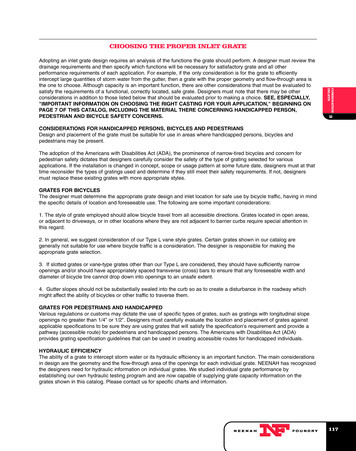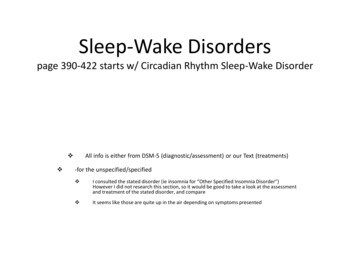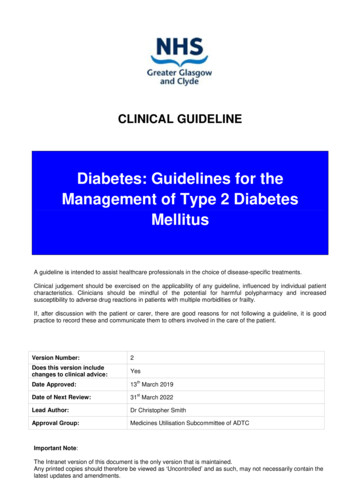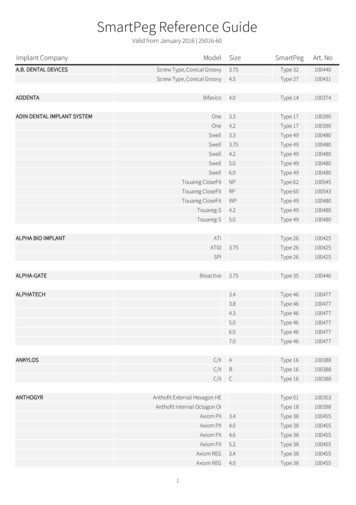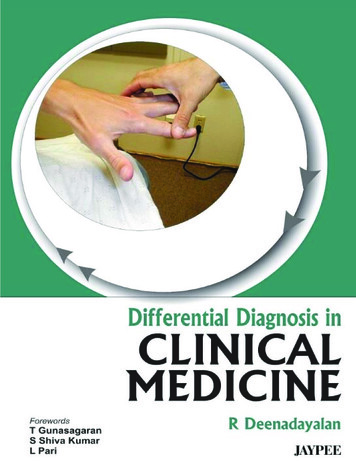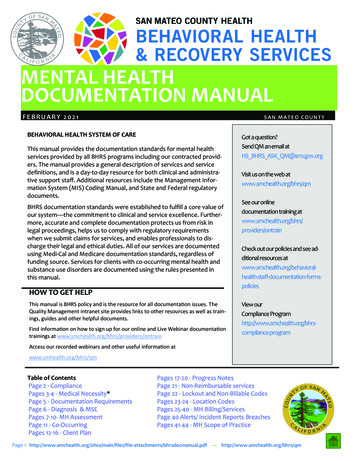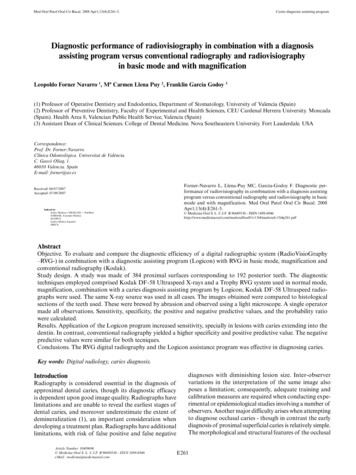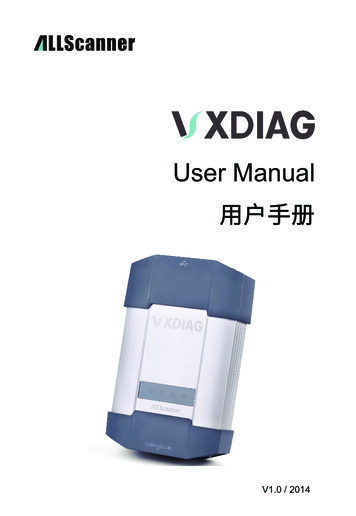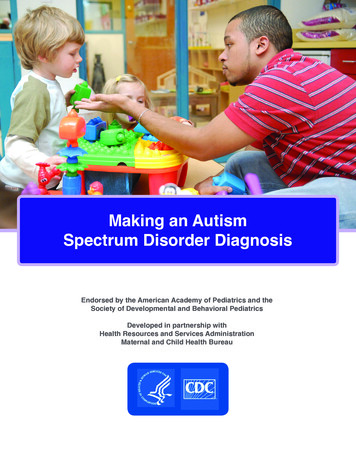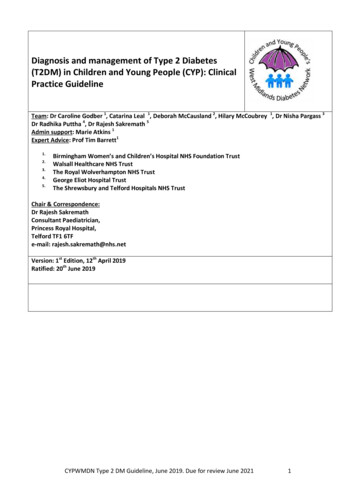
Transcription
Diagnosis and management of Type 2 Diabetes(T2DM) in Children and Young People (CYP): ClinicalPractice GuidelineTeam: Dr Caroline Godber 1, Catarina Leal 1, Deborah McCausland 2, Hilary McCoubrey 1, Dr Nisha Pargass 3Dr Radhika Puttha 4, Dr Rajesh Sakremath 5Admin support: Marie Atkins 1Expert Advice: Prof Tim Barrett11.2.3.4.5.Birmingham Women’s and Children’s Hospital NHS Foundation TrustWalsall Healthcare NHS TrustThe Royal Wolverhampton NHS TrustGeorge Eliot Hospital TrustThe Shrewsbury and Telford Hospitals NHS TrustChair & Correspondence:Dr Rajesh SakremathConsultant Paediatrician,Princess Royal Hospital,Telford TF1 6TFe-mail: rajesh.sakremath@nhs.netVersion: 1st Edition, 12th April 2019Ratified: 20th June 2019CYPWMDN Type 2 DM Guideline, June 2019. Due for review June 20211
Contents1. Introduction: .52. Diagnosis:.63. Type 2 Diabetes characteristics: .7Characteristics indicative of T2DM include: .7Further considerations at diagnosis: .7Diagnosis and determination of the diabetes type: .7History: .8Clinical assessment: .8Investigations: .84. Prediabetes: .95. Management Goals for T2DM: .96. Management of T2DM: .96.1 Lifestyle modification including weight loss advice and exercise management: .9Diet: . 10Weight management: . 10Blood glucose management (BG): . 10Healthy eating and key nutrients: . 10Vitamin D: . 11Vitamin B12: . 11Magnesium: . 11Cardiovascular health: . 11Exercise: . 116.2 Sleep: . 126.3 Glycaemic Control: . 12Self-Monitored Blood Glucose (SMBG): . 12HbA1c Monitoring: . 13CYPWMDN Type 2 DM Guideline, June 2019. Due for review June 20212
6.4 Pharmacological therapy: . 13Initial Treatment: . 14Subsequent Treatment: . 146.5 Structured Education for diabetes management: . 156.6 Smoking and substance misuse: . 166.7 Social and emotional support:. 166.8 Screening and management of comorbidities and complications: . 17Microalbuminuria: . 17Hypertension: . 18Treatment of hypertension: . 18Dyslipidaemia: . 18Hypertriglyceridemia: . 19Non-Alcoholic Fatty Liver Disease (NAFLD): . 19Diabetes Retinopathy: . 19Diabetes Neuropathy: . 20Diabetes Peripheral Neuropathy (DPN): . 20Diabetic Autonomic Neuropathy (DAN): . 20Polycystic Ovarian Syndrome (PCOS . 20Obstructive Sleep Apnoea (OSA): . 20Atherosclerosis and Vascular dysfunction:. 216.9 Immunisation:. 216.10 Dental examination: . 216.11 Additional health problems . 217. Surgery for CYP with T2DM: . 218. Other therapies and research update: . 21Bariatric surgery: . 23Current research studies: . 239 References: . 24CYPWMDN Type 2 DM Guideline, June 2019. Due for review June 20213
10. Appendices: . 27Appendix 1. BMI centile charts:. 27Appendix 2. Blood pressure centiles, Age 1- 17 years: . 29Appendix 3: Recommendations on methods of achieving goals: . 33Appendix 4: Nutrients – additional information: . 35Appendix 5: Exercise. 36CYPWMDN Type 2 DM Guideline, June 2019. Due for review June 20214
1. Introduction:The incidence of Type 2 diabetes (T2DM) in Children and Young People (CYP) is rising globally in parallel withthe rising rates of childhood obesity. In 2005, the UK annual incidence of T2DM in CYP 17 years was 0.53per 100,000 per year rising to 0.72 per 100,000 per year in 2015. The 2016-17 National Paediatric DiabetesAudit (NPDA) 33 reported that TD2M accounted for 2.5 % of the cohort. A proportionally higher number ofcases are seen in adolescent females and CYP from Black and Asian ethnic backgrounds. Additional riskfactors associated with T2DM include obesity, positive family history and low socioeconomic status.Approximately 35% of CYP are asymptomatic at diagnosis with the diagnosis being made after an incidentalglucose finding or further investigations for obesity related co-morbidities. Diagnostic challenges do remainas being overweight and obese can also occur in children diagnosed with Type 1 diabetes (T1DM). DiabeticKetoAcidosis (DKA) can be a presenting feature of T2DM with some series reporting a rate up to 25%.Accurate diagnosis of T2DM is critical for appropriate treatment, educational approaches, dietarymodification and prevention of adverse outcomes.T2DM in CYP compared to adults demonstrate unique features such as rapid decline in β cell function andaccelerated development of microvascular and macrovascular complications. Non-Alcoholic Fatty LiverDisease (NAFLD), hypertension, dyslipidaemia and microalbuminuria can be present at diagnosis and theprevalence increases with the duration of diabetes. This underlies the importance of screening for allcomplications and associated co- morbidities including Polycystic Ovarian Syndrome (PCOS), ObstructiveSleep Apnoea (OSA) and psychological co-morbidities.CYP onset T2DM has become more common, carries a high disease burden and is associated with increasedshort term and long term morbidity. Early detection, institution of a multi-faceted management approachand early screening and management of complications will help to preserve the future health of the affectedindividual.These clinical practice guidelines are based on the best available evidence. It incorporates guidancesurrounding diagnosis, initial and subsequent treatment, on-going monitoring and screening for andmanagement of complications.CYPWMDN Type 2 DM Guideline, June 2019. Due for review June 20215
2. Diagnosis: (according to American Diabetes Association criteria) 8Diagnosis of T2DM is based on measurement of glucose levels AND the presence of symptoms and requirestwo steps; Confirmation of the presence of diabetes, andDetermination of the type (mainly based on typical characteristics)Any one or more of these symptoms will give a diagnosis of diabetes, further investigations maybe neededfor the type of diabetes (T1DM, T2DM, MODY etc).1. Osmotic symptoms (polyuria, polydipsia, nocturia and unexplained weight loss) with random plasmaglucose 11.1 mmol/L ; or2. Fasting (defined as no caloric intake for at least 8 hours) plasma glucose levels 7 mmol/L or3.2 hour plasma glucose 11.1 mmol/L during an oral glucose tolerance test (OGTT) performed asdescribed by the World Health Organisation; or4. HbA1c equal to or greater than 6.5 % (48mmol/mol) (by equipment calibrated according toInternational Federation of Clinical Chemistry) but HbA1c is used with caution in the paediatricpopulation as sole means of diagnosis).5. It is extremely important that a medical professional explains the diagnosis of diabetes to the CYP andfamily. If determination of type of diabetes is unclear then further investigations will be warranted asdetermined by the guideline.Note: Asymptomatic CYP may have incidental hyperglycaemia when placed under conditions of acutestress (e.g. surgery, illness, infection). This effect is usually transient and does not constitute adiagnosis of T2DM.In the absence of symptoms, testing should be repeated on a different day to confirm abnormalfasting or post prandial glucose levels.Diabetes autoantibody testing (GAD54, IA2) should be considered in all CYP at diagnosis but thisis especially important in those presenting with DKA or in overweight /obese pubertal childrenwith a clinical picture of T1DM. 3, 24CYPWMDN Type 2 DM Guideline, June 2019. Due for review June 20216
3. Type 2 Diabetes characteristics: 29Characteristics indicative of T2DM include: Presentation can vary from asymptomatic hyperglycaemia to ketoacidosis in 25% of patients orHyperglycaemic Hyperosmolar State (HHS). Having a strong family history of T2DM. Being obese (BMI equal to greater than 98th percentile for age and gender) at presentation. Being of Black or Asian family origin. Having no insulin requirement, or having an insulin requirement of less than 0.5 units/kg bodyweight/day after the partial remission phase. Showing evidence of insulin resistance (for example acanthosis nigricans).Note: There is increasing trend of obesity of up to 30% in CYP with T1DM or patients with MODY. 248DKA occurs in up to 25% of CYP aged 10-19 years with T2DMFurther considerations at diagnosis:Diagnosis and determination of the diabetes type:Consider measuring C-peptide after initial presentation (e.g. 6 months) if there is difficulty distinguishingT2DM from other types of diabetes. Be aware that C-peptide concentrations have better discriminative valuethe longer the interval between initial presentation and the test. 29Diabetes Autoantibodies can be present in 10-20% of those with a clinical diagnosis of T2DM and predicts arapid development of insulin requirements and also highlights a risk of developing other autoimmunediseases.Since 4.5 – 8% of CYP with clinical features suggestive of T2DM have been found to have monogenic8diabetes, genetic testing for monogenic form should be considered as well. A non-fasting (random) blood C-peptide value of equal to or greater than 600pmol/L indicatessubstantial endogenous insulin secretion and is consistent with hyperinsulinism seen in tide-ranges-2.png) The MODY Probability Calculator can be used for further assessment and is available -calculator/CYPWMDN Type 2 DM Guideline, June 2019. Due for review June 20217
The presence of clinically relevant associated complications and comorbidities should be assessed at thetime of diagnosis:History:History should be obtained about symptoms: Obstructive Sleep Apnoea (OSA): night time snoring, day time sleeping Pregnancy PCOS, irregular periods, hirsutism, acne Emotional well-being Smoking Current diet and activity levels at the time of diagnosis.Clinical assessment:At the time of diagnosis, the following should be assessed: Measurement of weight, height, BP and calculation of BMI.Point of care blood glucose test.General and systemic examination To look for signs of insulin resistance (e.g. acanthosis nigricans), liver disease (e.g. xanthomas).Investigations:The following investigations should be done at the time of diagnosis: A laboratory Blood glucose test.HbA1cFasting Lipid profileLiver enzymes (LFT).Urea and electrolytes (U&E’s).Blood gas and lactate.Consider OGTT only where there is significant diagnostic uncertainty.Diabetes autoantibodies(GAD54, IA2) should be considered, if clinically indicatedUrine albumin/creatinine ratio (ACR).High triglycerides and reduced HDL-Cholesterol (HDL-C) are the hallmarks of the dyslipidaemia characteristicof insulin resistance and T2DM. Hypertension is associated with endothelial dysfunction, arterial stiffnessand increased risk of both cardiovascular and kidney disease.Hypertriglyceridemia, decreased HDL-C and hypertension can occur in CYP within few months of diagnosis ofT2DM. Micro and macroalbuminuria may be present at the time of diagnosis.CYPWMDN Type 2 DM Guideline, June 2019. Due for review June 20218
LFTs, U&E’s may be abnormal at time of diagnosis, especially if the young person presents with metabolicderangement. Consider repeating at the first outpatient visit.4. Prediabetes: 24CYP who do not meet the diagnostic criteria for diabetes but are having glucose levels, which are higher thanthe expected range according to Oral Glucose Tolerance Test (OGTT) values, are at a higher risk ofprogression to diabetes. IFG: Impaired fasting glycaemia. Fasting plasma glucose levels 5.6-6.9 mmol/L. IGT: Impaired glucose tolerance. Post challenge plasma glucose levels 7.8-11.0 mmol/L. HbA1c 40-46 mmol/mol (5.7% to 6.4%).Obese adolescents may have transient prediabetes with 60% reverting to normal OGTT levels within 2 years.Persistent weight gain is a predictor for persistent prediabetes and diabetes progression. Review these CYPannually.Some CYP may have elevated HBA1c levels but normal OGTT, likely to reflect daily carbohydrate intakeexceeding that associated with the standard glucose load (75g glucose). 8, 24Some CYP who meet the criteria for IFG or IGT may be euglycaemic in daily lives with normal HbA1c levels.Diet and lifestyle modification has been shown to be effective for adolescents with pre diabetes with noevidence for metformin use.5. Management Goals for T2DM: 241.2.3.4.5.Lifestyle modificationNormalisation of glycaemic controlEmotional well beingEducation for diabetes self-managementControl of comorbidities (including hypertension, dyslipidaemia, nephropathy, sleep disorders andhepatic steatosis)6. Smoking cessation6. Management of T2DM:6.1 Lifestyle modification including weight loss advice and exercise management:The main purpose of a lifestyle intervention for those diagnosed with T2DM is to support the whole family,often in making quite substantial changes. These include a focus on healthy eating; looking at a number ofspecific areas of diet as outlined below, as well as on increasing levels of physical activity and ensuringadequate sleep is attained.Lifestyle changes can be extremely challenging and having a diabetes dietitian and psychologist as part of thediabetes team is helpful in fostering a non-judgmental approach that supports open dialogue around themotivation and barriers to change as well as the support needed.42Lifestyle changes should be tailored to individual family’s needs and existing lifestyle, including personalpreferences/routine, culture, beliefs, age/ maturity, social circumstances. Support systems should also beestablished.CYPWMDN Type 2 DM Guideline, June 2019. Due for review June 20219
Diet:Education and negotiated goals around dietary change should cover the following areas in relation to T2DM: Weight management BG management Healthy eating to ensure adequate micronutrient intake Heart healthWeight management:Establishing a stable weight should be the immediate aim of lifestyle advice, followed by slow andsustainable weight loss (e.g. 0.5 -1 kg per month) from one month onwards. Explore a variety of differentdiet options as it is likely to help with finding a plan that is a best fit to the individual family’s structure andneeds.Examples include: A reduced or moderate carbohydrate approach (26-45% of energy). Healthy eating with general portion size reduction. Attendance at a slimming club may be beneficial. (programmes are available for CYP who attendwith a parent/guardian)A pilot study on very low calorie diets (VLCDs) in adolescents has been carried out 20 but it is considered tooearly to make recommendations in this area. Eligibility for this diet needs defining and further experience inthis area will allow for future recommendations.The aim needs to be to choose a sustainable option that provides an energy deficit of around 300- 500 kcaldepending on the CYP’s weight/BMI at diagnosis.Consider increasing both fibre and protein in the diet as it may make it easier to reduce overall meal timeportion sizes. 9 Care does need to be taken not to increase total energy intake if encouraging a higherprotein intake to increase satiety.Combining food diaries with recording mood, triggers for over-eating, activities and exercise may be usefulfor more detailed discussions around behaviour change.Blood glucose management (BG):Education should be offered on carbohydrate awareness, as it is the key nutrient that affects post meal BGlevels as well as portion sizes.Making associations between diet and BG levels can be encouraged by: Facilitating recording (food diary may help or APPs for recording such as MyFitness Pal) Association between quantity and frequency of food with BG excursions Educating the families on the concept of Glycaemic Index (GI) of carbohydratesFood diaries will help to determine an appropriate number of meals and snacks per day, which will alsodepend upon the diabetes treatment option and on individual preference. The total energy intakerecommended can be broken down accordingly across the day. The intake of diet that has carbohydrate withlow/medium GI may improve HbA1C up to 0.5%. 40Healthy eating and key nutrients:Vitamin D, B12 and magnesium are of particular importance in T2DM.CYPWMDN Type 2 DM Guideline, June 2019. Due for review June 202110
Vitamin D:A systematic review and meta-analysis suggests that Vitamin D supplementation showed an increase in26serum 25(OH) D and reduced insulin resistance . Other studies have shown a reduction in average BGlevels when deficiency in vitamin D is corrected.33 Vitamin D deficiency is also linked with depression 45,which is also very common in T2DM.Scientific Advisory Committee on Nutrition (SACN) identify that those at particular risk of Vitamin Ddeficiency include anyone of Asian origin due to darker pigmentation and women whose skin is covered.Those with a higher BMI, with diabetes and who are not physically active or smoke are also more likely tohave lower vitamin D levels. 36 Most Vitamin D comes from sun exposure. Good dietary sources include oily36fish and fortified cereals and margarine; see local Vitamin D guidelines for more information.Vitamin B12:Although no specific studies have been done in CYP, adults with T2DM appear to have a higher incidence ofvitamin B12 deficiency compared to those without14. If patients are on Metformin and/or if families arevegan or even vegetarian and/or if the young person has hypothyroidism, greater attention should be paidto sources of vitamin B12 in the diet as this is known to be reduced when adhering to these diets and also inthose taking Metformin regularly. Good dietary sources of vitamin B12 include eggs, diary, meat, fish andshellfish as well as fortified cereals. More details on recommended intake and dietary sources are availablein Appendix 4.Magnesium:If the diet includes a lot of refined carbohydrates and families are not able to add in wholegrain and the dietis low in fruit and vegetables, supplementation may be appropriate but would not be a first line approach asany weight loss programme will encourage an increased intake of these foods. Magnesium supplementationhas been shown to improve insulin sensitivity in CYP with T2DM10, 28 emphasising the importance ofencouraging good sources in the diet. See Appendix 4 for further details of recommendations on dietarysources and nutritional supplementation. Dietary consult from Paediatric diabetes dietitian is recommendedfor assessment and optimal dietary management. Dietary sources of magnesium include: wholegrains, greenleafy vegetables, nuts and beans.Cardiovascular health:The key recommendations for promoting a healthy heart are: 12, 42 Reduce salt intake for its effects on Blood Pressure (BP). Include oily fish in the diet for vitamin D and for omega-3 oils. Include 5 portions of vegetables or fruit and vegetables as this provides vital micronutrients, fibreand antioxidants.Exercise:All CYP should be encouraged to engage in moderately intense activity for 15 minutes a day andgradually building up to 60 minutes every day and in more vigorous activity at least 3 times a week;these activities should result in a faster heartbeat and difficulty carrying on a conversation. Examplesinclude swimming, football; or dancing and exercise DVDs in the privacy of their own homes.17TV/screen time should be reduced to no more than 2 hours per day.For further recommendations on a practical approach to introducing exercise to sedentary youngpeople, see Appendix 5Both muscular fitness and cardiorespiratory fitness are independently associated with metabolic risk ofinsulin resistance and therefore T2DM 24 It is worth noting that a 16 week study doing resistance trainingCYPWMDN Type 2 DM Guideline, June 2019. Due for review June 202111
twice a week significantly increased insulin sensitivity in overweight adolescents. 37Young people of Indian, Pakistani, Bangladeshi and Chinese background were found to participate inexercise and sports less than the general population 30, 31. Special efforts should therefore be made toencourage an increase in these populations.The importance of exercise should be stressed in relation to the following: To increase exercise tolerance for heart health as well as utilisation of fat stores through regularaerobic activity, gradually building up to 60 minutes every day.A means of reducing post meal BG levels if doing high intensity exercise post meals 9and also HbA1C (independently of weight loss).A way of burning energy (kcals) and promoting gradual weight loss.To decrease BP and cholesterol levels, reducing the risk of cardiovascular morbidity and mortality.To improve bone mineral density.Improve mood.Promotion of an active lifestyle can be done in the following ways: By encouraging walking to school/college, using the stairs instead of taking the lift etc. Also considerhousework as a way of burning energy (kcals). See appendix 5 for examples of energy used.Discussing how to decrease hours watching TV, playing games, using iPad, phone etc. to no morethan 2 hours a day and find other things to do in free time.Encouraging the CYP with T2DM to join local community based exercise programmes and find asport or type of exercise that they like.Provide information on appropriate cards/means of access to exercise at cheaper prices/discountsthat may be available via GPs/councils/local leisure centres.Encourage the use of APPs that facilitate recording of activity levels and introduce an element ofcompetition– e.g. fit bits or APPs for families or look at schemes such as Couch to 5K.Exercise for those CYP on insulin needs to be discussed with an HCP prior to undertaking. SeeAppendix 5 for further details of recommended insulin adjustments around exercise.6.2 Sleep:Children who don’t get the recommended period of sleep are more likely to be overweight. Teenagersshould sleep from 8 to 10 hours per 24 hours to promote optimal health, weight and BG management. 32, 44There is some evidence to suggest that good quality sleep is associated with a lower HbA1c in adults with25T2DMSuggestions on how to achieve the recommended sleeping time are 38 For screens to be turned off at least 30 minutes before bedtime. Keep TV and computers out of the bedroom. Keep room cool, dark and quiet. Avoid caffeine. Dim the lights and undertake calm activities such as reading.6.3 Glycaemic Control:Self-Monitored Blood Glucose (SMBG): 7, 8, 24Unlike in T1DM, the evidence that SMBG has an impact on glycaemic control in the individual with T2DM islimited. However they are essential if a CYP is on a glucose-lowering agent such as insulin, to help recognise,CYPWMDN Type 2 DM Guideline, June 2019. Due for review June 202112
treat, and avoid hypos.SMBG should be performed regularly. The frequency of SMBG should be individualised, and include acombination of fasting and postprandial glucose measurements with a frequency based on the degree ofglycaemic control and available reso
1. Osmotic symptoms (polyuria, polydipsia, nocturia and unexplained weight loss) with random plasma glucose 11.1 mmol/L ; or 2. Fasting (defined as no cal oric intake for at least 8 hours) plasma glucose levels 7 mmol/L or 3. 2 hour plasma glucose 11.1 mmol/L during an oral glucose tolerance test (OGTT) performed as
